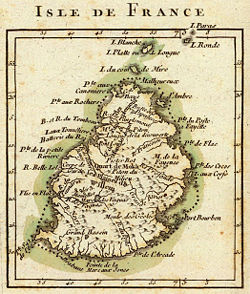Isle de France | |||||||||
|---|---|---|---|---|---|---|---|---|---|
| 1715–1810 | |||||||||
|
Flag (1715–1791) | |||||||||
| Motto: "Stella Clavisque Maris Indici" (Latin) "Star and Key of the Indian Ocean" | |||||||||
| Anthem: Marche Henri IV (1715–1792) Chant de guerre pour l'Armée du Rhin (1792–1804) Chant du départ (1804–1810) | |||||||||
 Map of Isle de France by Rigobert Bonne, 1791 | |||||||||
| Status | Colony of France | ||||||||
| Capital | Port Louis | ||||||||
| Common languages | French Mauritian Creole | ||||||||
| Governor | |||||||||
• 1721–1725 (first) | Denis, chevalier de Nyon | ||||||||
• 1803–1810 (last) | Charles Decaen | ||||||||
| Historical era | Early modern | ||||||||
• Established | 20 September 1715 | ||||||||
| 3 December 1810 | |||||||||
• Ceded to the United Kingdom | 30 May 1814 | ||||||||
| Population | |||||||||
• 1735 | 838 | ||||||||
| Currency | French livre (until 1794) French franc (from 1794) Napoléon (from 1803) | ||||||||
| |||||||||
| Today part of | British Indian Ocean Territory Mauritius Tromelin Island | ||||||||
Isle de France (Modern French: Île de France) was a French colony in the Indian Ocean from 1715 to 1810, comprising the island now known as Mauritius and its dependent territories. It was governed by the French East India Company and formed part of the French colonial empire. Under the French, the island witnessed major changes. The increasing importance of agriculture led to the "import" of slaves and the undertaking of vast infrastructural works that transformed the capital Port Louis into a major port, warehousing, and commercial centre.[1]
During the Napoleonic Wars, Isle de France became a base from which the French navy, including squadrons under Rear Admiral[2] Linois or Commodore Jacques Hamelin, and corsairs such as Robert Surcouf, organised raids on British merchant ships.[1] The raids (see Battle of Pulo Aura and Mauritius campaign of 1809–1811) continued until 1810 when the British sent a strong expedition to capture the island. The first British attempt, in August 1810, to attack Grand Port resulted in a French victory, one celebrated on the Arc de Triomphe in Paris. A subsequent and much larger attack launched in December of the same year from Rodrigues, which had been captured a year earlier, was successful. The British landed in large numbers in the north of the island and rapidly overpowered the French, who capitulated (see Invasion of Isle de France). In the Treaty of Paris (1814), the French ceded Isle de France together with its territories including Agaléga, the Cargados Carajos Shoals, the Chagos Archipelago, Rodrigues, Seychelles, and Tromelin Island to the United Kingdom.[3] The island then reverted to its former name, 'Mauritius'.
- ^ a b "The French period (1715-1810)". Government of Mauritius. Archived from the original on 19 September 2012. Retrieved 26 September 2012.
{{cite journal}}: Cite journal requires|journal=(help) - ^ French:Contre-amiral
- ^ Treaty of Paris (1814) - Art. VIII: « His Britannic majesty stipulating for himself and his allies, engages to restore to his most Christian majesty, within the term which shall be hereafter fixed, the colonies, fisheries, factories, and establishments of every kind, which were possessed by France on 1 January 1792, in the seas and on the continents of America, Africa, and Asia, with the exception however of the islands of Tobago and St. Lucie, and of the Isle of France and its dependencies, especially Rodrigues and Les Sechelles, which several colonies and possessions his most Christian majesty cedes in full right and sovereignty to his Britannic majesty, and also the portion of St. Domingo ceded to France by the treaty of Basle, and which his most Christian majesty restores in full right and sovereignty to his Catholic majesty »
